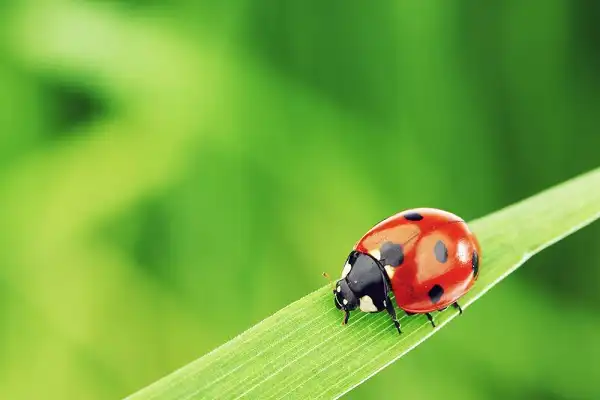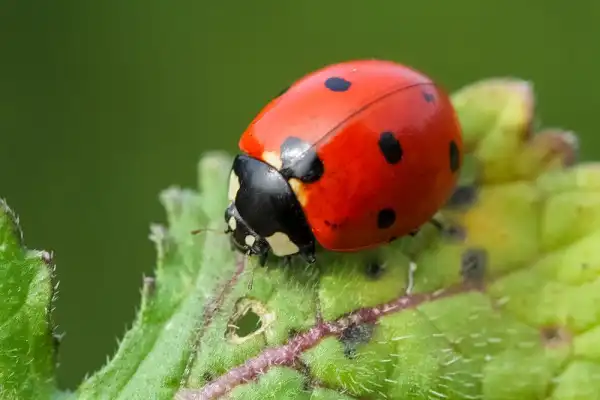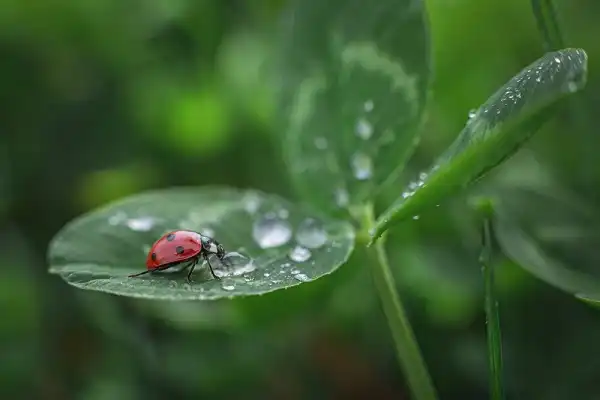Have you ever seen a ladybug fluttering around in your garden? These small, spotted creatures are beloved by many of us for their magical shimmer and remarkable cuteness. But have you ever stopped to consider that these insects may provide more benefits than just visual appeal? From playing an important role in the natural balance of ecosystems to providing an abundance of scientific knowledge, ladybugs truly are amazing! So come on a journey with me as I reveal why ladybugs should be celebrated and appreciated!

Ladybug Description
Ladybugs, also known as lady beetles or ladybird beetles, are small, dome-shaped insects that have vibrant red and black coloration. Some species of ladybugs may be yellow and black, orange and black, or even cream and brown. Ladybugs have two antennae that help them sense their surroundings and find food. Each ladybug has up to 16 spots on its back, which can vary in number from species to species. These spots are thought to act as a warning sign for potential predators so they know not to eat the tiny insect. The spots also serve as a camouflage to blend in against foliage or bark. The underside of the bug is usually pale yellow or white with small patches of orange or red near the head area. Ladybugs possess 2 sets of wings tucked neatly under their outer shell. This helps them fly swiftly while searching for food sources like aphids and other small invertebrates.
Ladybug Habitat
Ladybugs can be found all over the world, inhabiting a variety of ecosystems from gardens to woodlands. They prefer warm climates and can often be seen flitting around in sunny spots during the warmer months of the year. However, some species of ladybugs are known to hibernate in colder regions, migrating away from their more temperate habitats to avoid the cold weather. When looking for an ideal habitat, ladybugs prefer areas that are abundant in their favorite food sources such as aphids and other small insects. Trees, shrubs, flowers, and garden plants provide plenty of opportunities for ladybugs to feed on these creatures while also giving them somewhere to hide away from predators. Ladybugs are also attracted to areas with lots of sunshine as they need warmth in order to fly and find new food sources. In addition to providing food and shelter, some species of ladybugs also take advantage of tree bark or rock crevices for protection from predators like birds and spiders. While some ladybugs make their home in trees or rocks, others may nest near ground level in dirt mounds or burrow beneath leaf litter or soil where they’re safe from predators.
Ladybug Diet
Ladybugs are omnivorous and their diets consist of both plant and animal matter. They primarily feed on small invertebrates such as aphids, scale insects, mites, caterpillars, and other soft-bodied insects. Ladybugs will also eat pollen from flowers when searching for nectar or when their insect prey is scarce. Not only do ladybugs play a crucial role in keeping pest populations in check, but they also act as pollinators to help further the growth of plants. In addition to aphids and other small insects, ladybugs may consume pollen from flowers during their search for nectar. As they move between flowers in search of food sources, they help spread pollen from one plant to another, aiding in the pollination process. Apart from eating small invertebrates and flower pollen, some species of ladybugs may also feed on fungi or decaying organic matter like dead leaves and plant debris. This helps them get the essential nutrients they need to survive while cleaning up their environment at the same time.

Ladybug Size
Ladybugs are typically small insects, ranging from 3 to 8 millimeters in length. While they may appear delicate and fragile, they have a surprisingly powerful bite that allows them to pierce their prey and extract its juices for sustenance. Depending on the species, ladybugs can vary in size; some species may be smaller than others or even larger than average. The Asian Harlequin Ladybug is one of the smallest species of ladybug and measures around 2 mm in length, while the Seven-spotted Ladybug is one of the largest and can grow up to 10 mm. The size difference between these two species is quite remarkable! The size of a ladybug also depends on its age; adult ladybugs are usually bigger than larvae or nymphs since they have fully grown wings and exoskeletons. Adult ladybugs often have well-developed outer shells compared to immature bugs which are still molting and growing their wings.
Ladybug Lifespan
The average lifespan of a ladybug is typically 1 to 2 years, with some species living up to 3 years. Depending on the species, female ladybugs may live longer than males due to their greater reproductive capacity. However, most species have an annual life cycle that includes egg-laying, larval development, pupation, and adult emergence in the spring. Though their lifespans are relatively short compared to other insects, ladybugs make up for it with their prolific reproduction and fast growth rate. In warmer climates, they can produce multiple generations each year while in cooler areas they may only be able to produce one generation annually. The timing of a ladybug’s life cycle depends on the availability of food sources as well as environmental factors like temperature and humidity. As winter approaches, many species will migrate south or enter a state of hibernation in order to survive cold temperatures. During this time, they become dormant and their metabolism slows drastically until conditions become hospitable again.
Ladybug Behavior
Ladybugs are known for their impressive maneuverability, being able to fly in tight circles and change directions quickly while in flight. This is thanks to the set of two pairs of wings located on the dorsal side of their body, which helps them navigate through even the trickiest of environments. They will often land and take off again with little effort so that they can reach previously inaccessible areas or dodge potential predators. Ladybugs are solitary creatures who do not usually form large colonies; instead, they prefer to live and hunt alone. During mating season, male and female ladybugs will congregate to mate but won’t remain together for long afterwards. After successfully reproducing, the female will lay her eggs near a suitable food source so that her larvae can feed upon hatching.

Ladybug Speed
Ladybugs are incredibly agile creatures and possess the ability to move quickly. Depending on the species, they can reach speeds of up to 10 mph while in flight and cover large distances relatively quickly. They are also quite nifty on the ground, scurrying across surfaces at speeds of up to 2 mph. In addition to their impressive speed, ladybugs are also very maneuverable in flight and can take sharp turns or even U-turns with ease. This is due to their two pairs of wings which provide them with enhanced agility when navigating through different environments. The speed of a ladybug also depends on its size and age; smaller species tend to fly faster than larger ones due to their lower body weight, while adult ladybugs travel faster than larvae or nymphs since they have fully developed exoskeletons and wings.
Ladybug Species
Ladybugs are incredibly diverse creatures, with over 5,000 known species found around the world! They come in a variety of colors and sizes, ranging from small 2mm long species to large 10mm ones. Depending on the species, they can also have spots or patches of different shapes and sizes spread across their black or brown exoskeleton. They can be found in all kinds of habitats – from deserts to forests – and feed on a wide range of insects like aphids, caterpillars, scale insects, and mites. In addition to their diet, other factors such as temperature, humidity, and light levels can influence their behavior and where they decide to live. Interestingly enough, many ladybugs are polyphagous, meaning they feed on multiple types of prey during their lifetimes. This allows them to adapt easily to changing environmental conditions as well as provide us with essential services like pest control!
Ladybug Hunting
Ladybugs are skilled hunters, using both their keen vision and sense of smell to search for their prey. They use their eyes to spot potential food sources from far away and then hone in on them with their superior navigational capabilities. Additionally, they can also rely on their sense of smell to detect chemical signals secreted by insect larvae or aphids that indicate a good source of food. Once a ladybug has located its prey, it will use its two pairs of wings to pursue the insect while maneuvering with remarkable agility around obstacles in its path. They have the ability to quickly change direction or even perform tight U-turns as necessary to keep up with their prey before finally catching it with their strong legs or mouthparts.
Some species of ladybugs have even been observed using particular hunting strategies such as hovering in front of flowers or plants in order to better observe possible prey or waiting patiently on tree branches for unsuspecting insects to come within reach. In addition, they also possess other special adaptations which help them when searching for food; female ladybugs tend to be more active hunters than males, often spending a long time in pursuit compared to their male counterparts. This is due to the fact that females need more food resources when they are about to lay eggs as well as during the early stages of larval development.

Conclusion
In conclusion, ladybugs are amazing creatures whose fascinating adaptations make them well-suited to survive in a variety of habitats and climates. From their incredible speed and maneuverability to their impressive hunting skills, these fascinating creatures provide essential services like pollination and pest control that help maintain balance within our natural ecosystems! Ladybugs truly demonstrate the power of adaptation – something we should all take more time to appreciate!
Frequently Asked Question

